
Nikon D4 + Voigtländer 125mm f/2.5 — 1/320 sec, f/2.5, ISO 110 — map & image data — nearby photos
Blossom Tunnel
The Haradanien Garden (原谷苑), Kyoto, Japan (Apr 2013)
I'd prepared a few other “off-season spring-blossom” photos that didn't fit into yesterday's post, so I thought I'd just post them today. All but the last two are from April 2013.

Nikon D4 + Nikkor 14-24mm f/2.8 @ 14mm — 1/1250 sec, f/2.8, ISO 100 — map & image data — nearby photos
Odd Perspective
nice colors, but not a fan of the Nikkor 14-24/2.8 bokeh
Ryouanji Temple (龍安寺), Kyoto Japan
This was from the same trip that produced a wonderful bonanza of pictures that I've barely scratched the surface of.

Nikon D4 + Voigtländer 125mm f/2.5 — 1/800 sec, f/2.5, ISO 180 — map & image data — nearby photos
Temple Garden
Toji Temple (東寺), Kyoto Japan

Nikon D4 + Nikkor 50mm f/1.4 — 1/250 sec, f/3.5, ISO 100 — map & image data — nearby photos
Ryoanji's Famous Rock Garden
Ryouanji Temple (龍安寺)

Nikon D4 + Nikkor 24mm f/1.4 — 1/320 sec, f/10, ISO 500 — map & image data — nearby photos
Eden
The Haradanien Garden (原谷苑)

Nikon D4 + Voigtländer 125mm f/2.5 — 1/1000 sec, f/2.5, ISO 100 — map & image data — nearby photos
Cherry-Blossom Edge

Nikon D4 + Nikkor 200mm f/2 — 1/1000 sec, f/2, ISO 100 — map & image data — nearby photos
Layers
The Haradanien Garden (原谷苑)

Nikon D4 + Nikkor 200mm f/2 — 1/1600 sec, f/2, ISO 100 — map & image data — nearby photos
Target-Rich Environment
The Haradanien Garden (原谷苑)

Nikon D4 + Voigtländer 125mm f/2.5 — 1/400 sec, f/2.5, ISO 100 — map & image data — nearby photos
Subtle, Yet Festive
The Haradanien Garden (原谷苑)
The last few are from the amazing Haradanien Garden (原谷苑), which I've posted about at length in the past starting here.
I haven't done all that much blossom photography over the last two years, but I did snap this shot of the late-April blossoms on our recent trip to the northern-Japan Aomori prefecture, where we could see snow and cherry blossoms at the same time (though no snow in this shot):

Nikon D4 + Nikkor 24-70mm f/2.8 @ 31mm — 1/1250 sec, f/4.5, ISO 160 — map & image data — nearby photos
Late-April Cherry Blossoms
Hirosaki Park (弘前公園), Aomori Japan
This is the same trip with the big waterwheel.
Sort of unrelated, but on the flight I got this out-the-window shot of a mountain emerging from the mist, which I sort of like....

Nikon D4 + Voigtländer 125mm f/2.5 — 1/500 sec, f/11, ISO 2000 — map & image data — nearby photos
Peeking Peak
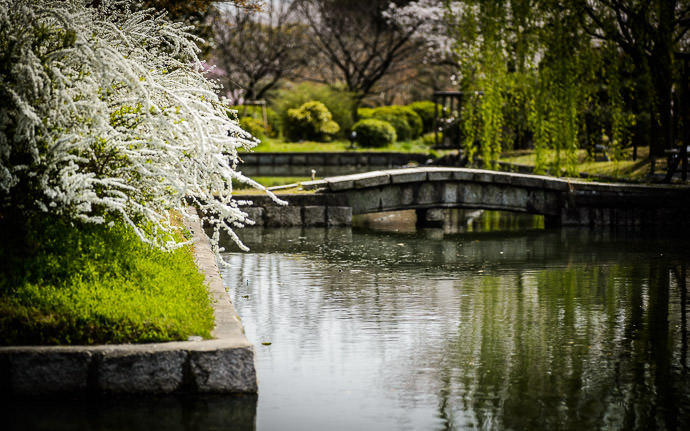
Nikon D4 + Voigtländer 125mm f/2.5 — 1/800 sec, f/2.5, ISO 140 — map & image data — nearby photos
Serene Japanese Garden
'cause nuts-n-bolts digital maintenance like this post is about can give a headache
Toji Temple (東寺), Kyoto Japan, April 2013
This post is about trimming down the file size of an Adobe Lightroom catalog. In keeping with the off-season them of my previous post (which was filled with fall-foliage photos), this post is sprinkled with a few photos from Kyoto springs past, chosen more for their mentally-calming effect than for photographic quality, which they generally lack. (Sorry)
In a nutshell, if you have a large Lightroom catalog, and if you don't need the detailed editing history for your photos, you might be able to significantly reduce the size of your Lightroom catalog by flushing that edit-history data, which might generally improve overall responsiveness when working in Lightroom.
As one data point, my personal Lightroom catalog holding data for 134,026 photos and videos went from 3.9GB to 1.7GB, a savings of 56%.
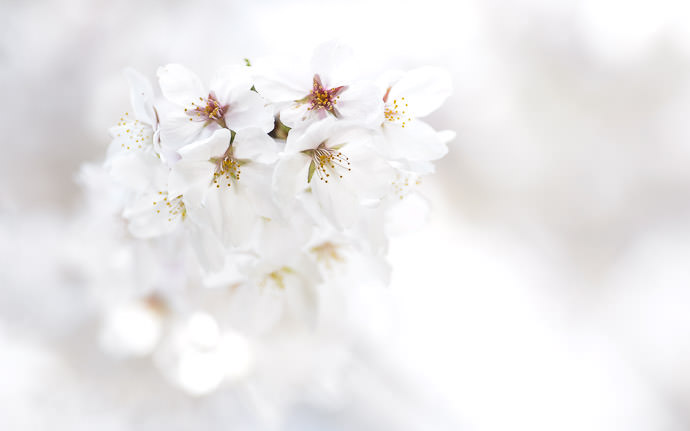
Nikon D4 + Voigtländer 125mm f/2.5 — 1/800 sec, f/2.5, ISO 100 — map & image data — nearby photos
Cherry-Blossom Whiteout
Before you can do this, you have to decide whether the edit history is data you don't want to keep. It's a log of every change made in the develop module, as illustrated here:
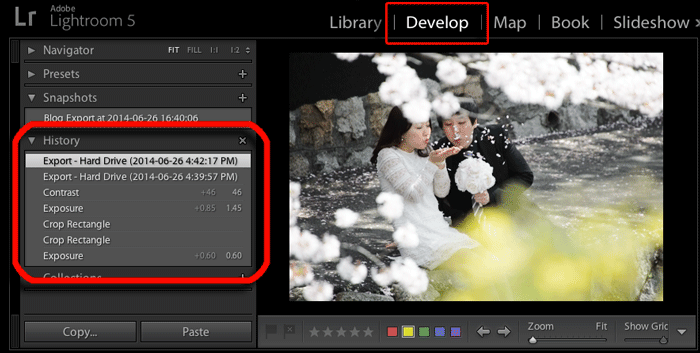
Lightroom allows you to return the image to any given step by clicking on the step in the list, which can be quite convenient while you're working on an image. But if you're like me, it's of practical use only while actively working on an image. For editing states that I want to save over time, I use either snapshots (such as automatically made via my Snapshot on Export plugin), or virtual copies.
So I personally don't need the step-by-step editing history to be saved for years and years in the catalog, so I hope I'll get some benefit by clearing it out.
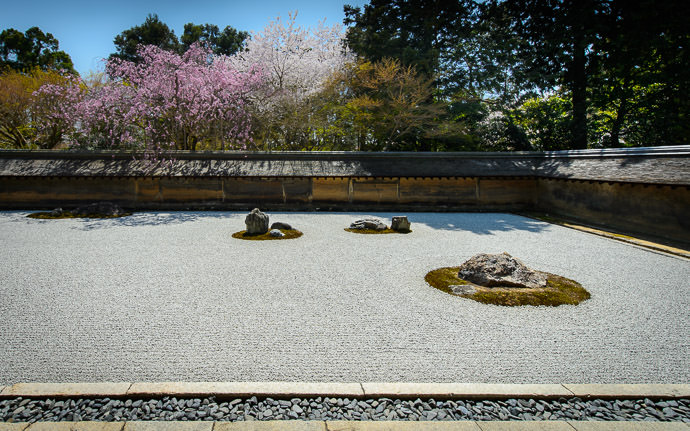
Nikon D4 + Nikkor 14-24mm f/2.8 @ 14mm — 1/100 sec, f/11, ISO 100 — map & image data — nearby photos
Rock Garden
Ryouanji Temple (龍安寺), Kyoto Japan, April 2013
Just how much benefit the clearing-out provides remains an open question. It's obviously better to have a smaller catalog file, though I haven't run any quantitative tests to put a number to it as I have in some earlier write-ups (such as I did in “An Analysis of Lightroom JPEG Export Quality Settings” and “A Qualitative Analysis of NEF Compression”).
A reduction in catalog size clearly makes backups smaller and faster, and you are backing up your Lightroom catalog, right? It contains a lot of data that would be painful if not impossible to recreate if you lost it. But one assumes a smaller file makes any of its database access quicker, and so day-to-day interaction with those aspects of Lightroom should, one reasons, be faster
The procedure is easy, but before doing it, it's perhaps interesting to know the size of your catalog file before flushing edit-history data, as a point of comparison with after. To check the file size, first optimize the catalog (in Lightroom, invoke “File > Optimize Catalog...”, exit Lightroom, then check the size of the “*.lrcat” catalog file using Finder or Explorer.
Then make a backup of the catalog file, just in case. You can do so by zipping up a copy in Finder or Explorer, or you can use Lightroom's backup mechanism, though the latter can be excruciatingly slow for large catalogs.
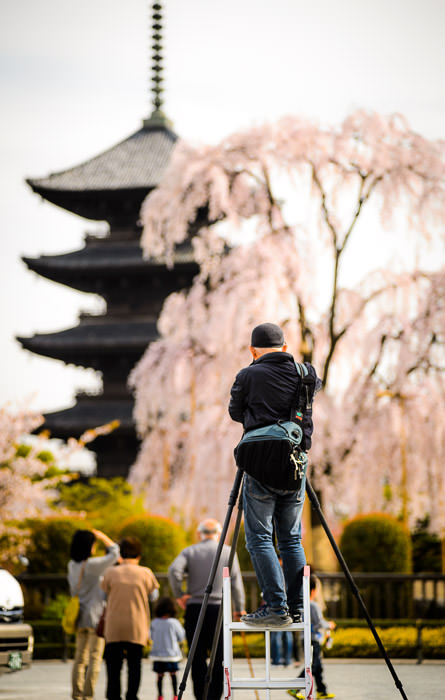
Nikon D4 + Voigtländer 125mm f/2.5 — 1/800 sec, f/2.5, ISO 140 — map & image data — nearby photos
Searching for Improved Performance
Toji Temple (東寺), Kyoto Japan, April 2013
Now to flush the edit-history data. Back in Lightroom, select the images that you want to do this to. I selected everything, but you can select a subset. You might select all but recent photos, for example.
If you want to select everything, it's a bit complex because of how Lightroom handles photos in stacks. First select “All Photographs” in the “Catalog” section in the upper left of Library, then visit the “Library” menu and make sure that “Enable Filters” doesn't have a checkmark (click “Enable Filters” if it does). Then “File > Select All” and then “Photo > Stacking > Expand All Stacks”. Then, finally, again invoke “File > Select All”, and now you should truly have every item in your library selected.
In any case, once you've made your selection, enter the Develop module, and invoke “Develop > Clear History...” menu item, and if you've selected more than one image, you'll be presented with a dialog:
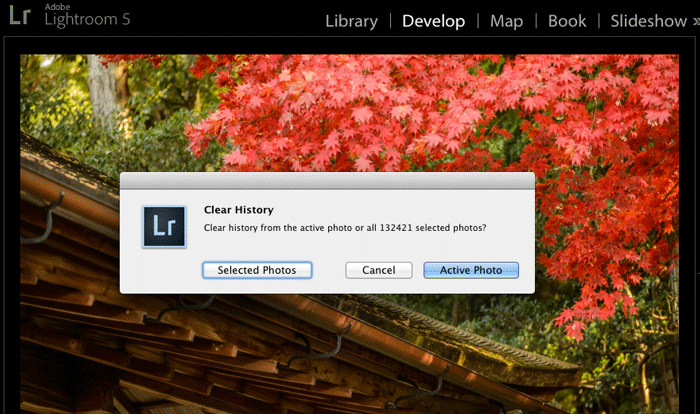
Choose “Selected Photos”.
You then have to wait “a while” for the process to complete. Lightroom gives no indication that anything is going on under the hood, but if you have a CPU-activity monitor running, you'll see it working for a while. It's unfortunate that Lightroom doesn't expose this background task's progress so you can know for sure when it's done. If you don't have a CPU-activity monitor, I'll blindly suggest waiting at least a minute for every 25,000 items selected.
You can use Lightroom while this is going on, or just let it sit.
Once you're ready to see the results, again invoke “File > Optimize Catalog...”, exit Lightroom, and inspect the new size.
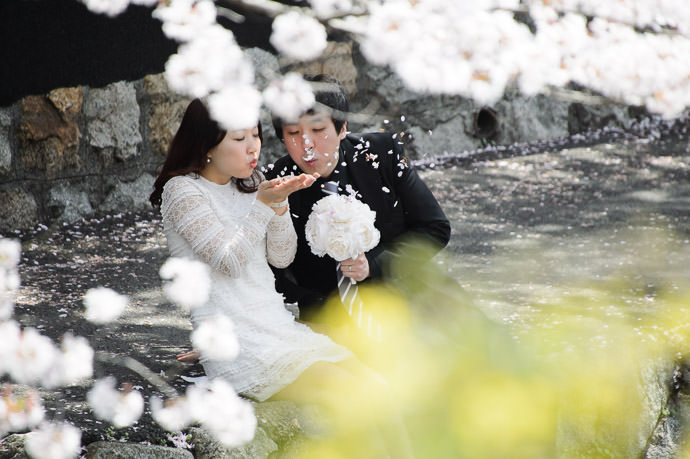
Nikon D4 + Sigma “Bigma” 50-500mm OS @ 500mm — 1/2000 sec, f/6.3, ISO 1000 — image data
Poof
your catalog file might be much smaller now
Mine reduced to less than half of what it had been, but your results will depend on your own editing history, of course. Lots of local-correction brush strokes, for example, makes for much larger history data, so when clearing it out, for much more savings.
If you choose to do this, how much savings for how large a catalog did you get?
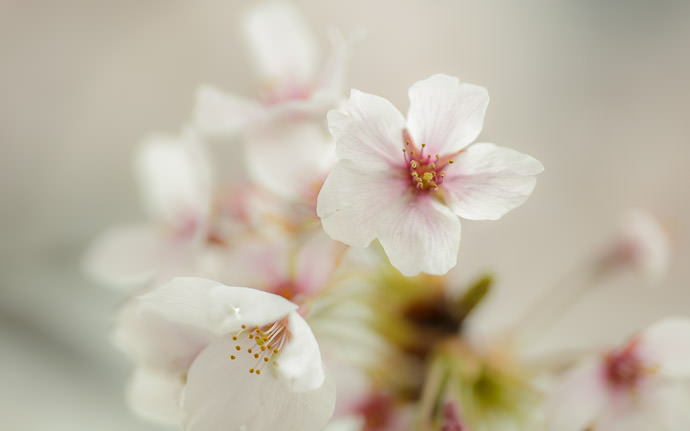
Nikon D4 + Voigtländer 125mm f/2.5 — 1/800 sec, f/2.5, ISO 160 — map & image data — nearby photos
Cherry Blossoms
a nice way to end any post

Nikon D4 + Nikkor 24mm f/1.4 — 1/50 sec, f/10, ISO 250 — map & image data — nearby photos
Too. Much. Color.
volunteer ground crews at the Shugakuin Imperial Villa (修学院離宮)
Nov 2013, Kyoto Japan
Chatting with a visitor to Kyoto yesterday, she said that she really wanted to see Japan's fall foliage sometime. That prompts me to dip into my archives for a fall-foliage post today, with photos from a visit last November to the Shugakuin Imperial Villa in north-east Kyoto.
It was a brilliantly bright day and even with my polarizer filter (which normally has a wonderful effect with fall colors) the photos seem washed out to me, but some are still not too bad.
This is my second visit, the first having been covered starting in “My First Visit To Kyoto’s Shugakuin Imperial Villa” where I explain a bit about the place.

Nikon D4 + Nikkor 85mm f/1.4 — 1/400 sec, f/1.4, ISO 100 — map & image data — nearby photos
Destroyer of Scenic Views
I'd prefer them to sprinkle more colorful leaves, rather than rake up what's there
As I explain in the post about my first visit, visiting is only by reserved tour, and it moves along at a brisk pace with little time to stop and compose a photo. Knowing this, I moved forward quickly so that I could stop and have a moment before the rest of the group caught up...

Nikon D4 + Nikkor 24mm f/1.4 — 1/50 sec, f/5, ISO 280 — map & image data — nearby photos
The First Gate

Nikon D4 + Nikkor 24mm f/1.4 — 1/60 sec, f/3.5, ISO 100 — map & image data — nearby photos
Moments Later

Nikon D4 + Nikkor 24mm f/1.4 — 1/80 sec, f/3.5, ISO 100 — map & image data — nearby photos
Not Far Inside the Gate

Nikon D4 + Nikkor 24mm f/1.4 — 1/50 sec, f/3.5, ISO 180 — map & image data — nearby photos
Narrow Path

Nikon D4 + Nikkor 24mm f/1.4 — 1/100 sec, f/3.5, ISO 100 — map & image data — nearby photos
Stark Sunlight
and this really looks as if I didn't use the polarizer. I wonder why.

Nikon D4 + Nikkor 24mm f/1.4 — 1/50 sec, f/16, ISO 1600 — map & image data — nearby photos
Lower Mossy Angle

Nikon D4 + Nikkor 24mm f/1.4 — 1/50 sec, f/16, ISO 640 — map & image data — nearby photos
A Bit Better light
The tour pauses for a moment at some minor outer building.

Nikon D4 + Nikkor 24mm f/1.4 — 1/50 sec, f/14, ISO 900 — map & image data — nearby photos
Minor Outer Building
with a couple of rooms

Nikon D4 + Nikkor 24mm f/1.4 — 1/50 sec, f/14, ISO 200 — map & image data — nearby photos
First Amazing Vista
that I just can't photograph well
The tour stops here for a couple of minutes so you can enjoy (and photograph) the view, which is nice, but both times I've been here I've not been able to do it justice. Here are the shots last time..
Later we come across a less-minor building that has some old paintings on the doors, of the hoko rolling floats of the Gion Matsuri Festival held every July for more than a thousand years...

Nikon D4 + Nikkor 24mm f/1.4 — 1/50 sec, f/10, ISO 2200 — map & image data — nearby photos
Room with Old Paintings
I posted a close up of the painting in an earlier post. In modern times, these old hoko are festooned with lanterns, so look like this and this.

Nikon D4 + Voigtländer 125mm f/2.5 — 1/250 sec, f/2.5, ISO 1600 — map & image data — nearby photos
Roof Detail

Nikon D4 + Voigtländer 125mm f/2.5 — 1/250 sec, f/11, ISO 5600 — map & image data — nearby photos
Protruding Nails

Nikon D4 + Nikkor 24mm f/1.4 — 1/50 sec, f/6.3, ISO 100 — map & image data — nearby photos
Tour Path
taken, literally, on the run to stay ahead of the group and get a clean shot
At some point along the path I turned around to get the trailing crowd...

Nikon D4 + Nikkor 24mm f/1.4 — 1/1600 sec, f/1.4, ISO 100 — map & image data — nearby photos
Deep in Conversation
tour-guide policeman explaining something to my friend Kentaro Kataoka
Japanese citizens wanting to visit the imperial sites in Kyoto must make reservations far in advance, but a foreigner (non-Japanese) can often make a same-day reservations. Each group of foreigners can bring one Japanese citizen with them, and this time I brought my masseur friend Kataoka-sensei. (Coincidentally, I had a massage from him today to handle a severely-pulled neck/shoulder muscle; the guy is a miracle worker.)

Nikon D4 + Nikkor 24mm f/1.4 — 1/160 sec, f/3.5, ISO 100 — map & image data — nearby photos
Another Gate

Nikon D4 + Nikkor 24mm f/1.4 — 1/50 sec, f/11, ISO 320 — map & image data — nearby photos
Closer View
as 30 folks bear down on me from behind

Nikon D4 + Nikkor 24mm f/1.4 — 1/50 sec, f/11, ISO 640 — map & image data — nearby photos
Climbing Up

Nikon D700 + Nikkor 24-70mm f/2.8 @ 70mm — 1/200 sec, f/2.8, ISO 800 — map & image data — nearby photos
Happy
A cake from October 29th, 2008
( placed on this post in 2014 for reasons we'll see below )
Today is the 25th anniversary of my first arrival in Japan.
来日25周年になりました!
It was June 19th, 1989 that I flew into Tokyo from California after having finished grad school and then lived with my brothers for several months while waiting for my work visa to be approved. I was met at the airport by Krish Kulkarni, whom I had never met, but had no trouble finding because he's the twin brother of my best friend at grad school, Ram Kulkarni (who later went on to be the best man at my wedding, and I at his).
A day or two later I made my way down to the Kyoto/Osaka region, where I started work as an engineer at Omron Tateishi Denki (オムロン立石電機).
I worked at Omron for about eight years, though spending much of the time in The States at Carnegie Mellon University as a “visiting researcher” (I was really a babysitter for a room full of computers that Omron had donated).
I eventually moved to The States to work for Yahoo!, but not long before I met the woman I would marry. She happened to be Japanese, and after about eight years in Silicon Valley we moved back to Japan, setting up our lives in Kyoto. That was 10 years ago this spring.
Along the way we moved into where we live now, I picked up photography as a hobby in earnest when I bought my first dSLR, and I started to develop plugins for Adobe Lightroom.
And that brings me to my second milestone. Almost six years ago I released my Geoencoding Support plugin. It was the eighth plugin for Adobe Lightroom out of what so far has been about fifty.
Back then, when I first announced it on October 29th 2008, the plugin didn't have any documentation beyond what I wrote on the announcement post. I should have provided complete documentation, but I didn't..... until today. Today, almost six years later, I finally got around to it, and changed the plugin's home page from a placeholder to a long description of all the plugin can do. If you use the plugin, check it out.
So why didn't I write up the documentation when I released the plugin? My Lightroom catalog tells me that I was busy that day with a party at Anthony's preschool for all the kids who had a birthday in October. So, I thought it would be fitting to post a few photos from that 2008 party today...

Nikon D700 + Nikkor 24-70mm f/2.8 @ 38mm — 1/160 sec, f/5, ISO 3200 — map & image data — nearby photos
Party Preparation

Nikon D700 + Nikkor 24-70mm f/2.8 @ 35mm — 1/200 sec, f/5, ISO 1400 — map & image data — nearby photos
“Happy Birthday!”

Nikon D700 + Nikkor 24-70mm f/2.8 @ 70mm — 1/200 sec, f/4, ISO 900 — map & image data — nearby photos
Buffet Lunch

Nikon D700 + Nikkor 24-70mm f/2.8 @ 62mm — 1/200 sec, f/4, ISO 800 — map & image data — nearby photos
Waiting To Start
he'd just turned six years old; now he's 11

Nikon D700 + Nikkor 24-70mm f/2.8 @ 52mm — 1/200 sec, f/4, ISO 1400 — map & image data — nearby photos
Building His Sandwich

iPhone 3Gs — f/2.8 — map & image data — nearby photos
Using My Camera
A Nikon D700 with a Nikkor 24-70/2.8 is heavy stuff for a newly-minted six year old

Nikon D700 + Nikkor 24-70mm f/2.8 @ 70mm — 1/200 sec, f/3.5, ISO 250 — map & image data — nearby photos
Three Cakes
for the three years' worth of kids in the school

Nikon D700 + Nikkor 24-70mm f/2.8 @ 48mm — 1/200 sec, f/2.8, ISO 720 — map & image data — nearby photos
Showing His Craft Project
I was happy to finally get the plugin documentation done today. Some of my other plugins have okay documentation, but perhaps 40 need serious work. Perhaps I'll start on the next in another 25 years...

Nikon D4 + Voigtländer 125mm f/2.5 — 1/250 sec, f/2.5, ISO 1600 — map & image data — nearby photos
Literally
melts in your mouth
Sirloin at Beefland Prince, Awaji Island, Japan
ビーフランド大公、淡路島
With Anthony away on a school trip, Fumie and I made a day-trip date to Awaji Island two hours by car south from Kyoto, where our first stop was a late lunch in heaven, A.K.A “Beefland Prince”.
息子は修学旅行中なので、妻と一緒に淡路島の日帰りデートをしました。まずは「ビーフランド大公」でめっちゃ美味いステーキを戴きました。

Nikon D4 + Nikkor 24-70mm f/2.8 @ 28mm — 1/80 sec, f/2.8, ISO 100 — map & image data — nearby photos
Sirloin Lunch

Nikon D4 + Voigtländer 125mm f/2.5 — 1/250 sec, f/2.5, ISO 560 — map & image data — nearby photos
Sizzling
it's served on a slab of very hot stone, so it continues to sizzle for quite some time
You can't begin to imagine how good this steak was. When I say the steak literally melts in your mouth, I'm literally using the word “literally” for its literal meaning... the fats in the meat just melt away. It's almost unearthly when compared to any other steak I've ever had in this life (including the fantastic teppanyaki steak I wrote about the other day; as good as it was, it's not in the same class as today's place).
Sadly, it's a two-hour drive away and is pretty pricey, so we can't enjoy it often. We last came four years ago.
Because I'm a camera geek, check out yet another example of the powerful impact a polarizing filter can have, in these two shots of the chopsticks' sleeve:
mouseover a button to see that image
What a difference.
I used a polarizer on the steak shots above, but only partially because as I wrote about in my first writeup on using a polarizer filter six years ago, a certain amount of shine/glare is usually appealing with food. I've also presented other examples of the filter with: fall foliage moss · wet rocks · a temple garden · lotus flowers · a stream.
Anyway, this was our third time at this restaurant. I thought I'd posted about it in years past, but for the life of me I can't find any evidence. Here are some shots from our last visit four years ago...
次の写真は4年前の写真です。

Nikon D700 + Sigma “Bigma” 50-500mm OS @ 58mm — 1/640 sec, f/8, ISO 250 — map & image data — nearby photos
Sign at the Road

Nikon D700 + Nikkor 24-70mm f/2.8 @ 36mm — 1/1600 sec, f/2.8, ISO 200 — map & image data — nearby photos
Outdated Look

Nikon D700 + Sigma “Bigma” 50-500mm OS @ 50mm — 1/640 sec, f/8, ISO 5600 — map & image data — nearby photos
Entrance

Nikon D700 + Nikkor 24-70mm f/2.8 @ 52mm — 1/100 sec, f/2.8, ISO 6400 — map & image data — nearby photos
Inside: Dated and Dirty
The impression of the place is not good... until you're served, then all else is forgotten.
For historical-archival purposes, my steak four years ago:

Nikon D700 + Nikkor 24-70mm f/2.8 @ 70mm — 1/125 sec, f/2.8, ISO 2000 — map & image data — nearby photos

Nikon D700 + Nikkor 24-70mm f/2.8 @ 70mm — 1/125 sec, f/3.5, ISO 1250 — map & image data — nearby photos
Fumie had the filet mignon, which tasted just as exquisite but had quite a different look:

Nikon D700 + Nikkor 24-70mm f/2.8 @ 70mm — 1/125 sec, f/3.5, ISO 560 — map & image data — nearby photos




